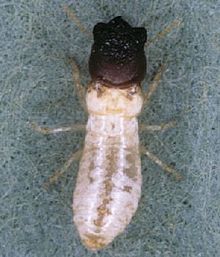Kalotermitidae
| Kalotermitidae | |
|---|---|

| |
| Cryptotermes brevis | |
| Scientific classification | |
| Domain: | Eukaryota |
| Kingdom: | Animalia |
| Phylum: | Arthropoda |
| Class: | Insecta |
| Order: | Blattodea |
| Infraorder: | Isoptera |
| Parvorder: | Euisoptera |
| Family: | Kalotermitidae Froggatt, 1897 |
Genera
| |
|
See text | |
Kalotermitidae is a family of termites, commonly known as drywood termites. Kalotermitidae includes 21 genera and 419 species. The family has a cosmopolitan circumtropical distribution, and is found in functionally arid environments.
Biology
The Kalotermitidae are "primitive" in morphology, nesting behavior, and social organization. Unlike other termite species, they have no need to make contact with soil[1] and live exclusively within excavations in wood, lacking elaborate nesting architecture.[2]
Drywood termites have an adaptive mechanism for conserving water. Undigested matter in the alimentary canal passes through specialized rectal glands in the hindgut. These glands reabsorb water from the feces. They can tolerate dry conditions for long periods of time, receiving all of the moisture they need from the wood they live in and consume. Their mandibles are also fortified with zinc, as an adaptation to the mechanically difficult food source of dry wood.[3]
Their diet of dry wood makes many of them economic and urban pests, causing damage to furniture, utility towers, stored wood, and buildings. Kalotermitids' global distribution may be partially attributable to rafting and timber movement.[4] The species Cryptotermes brevis is particularly prevalent as a pest in the United States, and is found in Hawaii, Florida, and along the southeastern coast.
Reproduction
Like other termites, the Kalotermitidae are
Alates fly during warm, sunny days, when temperatures range from 80 to 100 °F (27 to 38 °C). They emerge from exit holes in wood and take off in all directions. They exhibit phototropic behavior during dispersal flights, often aggregating at lights, with at least one species showing a preference for light with a wavelength between 460 and 550 nm.[7] After landing, they break off their wings which they do by holding their wingtips against a substrate and turning until the wing breaks off at the base. Dealates find a mate and engage in courtship activity.[8] King and Queen mate for life.
Systematics
The Kalotermitidae belong to the "lower termites", a now-defunct
The Kalotermitidae have no recognized classification above genera,[4] the relationships between which are still largely unknown and poorly studied.[2] Limited molecular evidence supports the genus Kalotermes as a basal lineage within the family, so is one of the most anciently diversifying, as well as having two major branches, in which Kalotermes is sister to Ceratokalotermes. However, this partially contradicts older morphological phylogenies, and is the result of a study limited to eight genera.[2] The most extensive phylogenetic study of drywood termites revealed several instances of long-distance transoceanic dispersal during their extensive evolutionary history.[14]
Genera
- Allotermes Wasmann, 1910
- Bicornitermes Krishna, 1961
- Bifiditermes Krishna, 1961
- Calcaritermes Snyder, 1925
- Ceratokalotermes Krishna, 1961
- Comatermes Krishna, 1961
- Cryptotermes Banks, 1906
- †Electrotermes Rosen, 1913
- †Eotermes Statz, 1939
- Epicalotermes Silvestri, 1918
- Holmgren, 1911
- Glyptotermes Froggatt, 1897
- †Huguenotermes Engel & Nel, 2015
- Incisitermes Krishna, 1961
- †Kachinitermes Engel, Grimaldi, & Krishna, 2007
- †Kachinitermopsis Engel & Delclòs, 2010
- Kalotermes Hagen, 1853
- Longicaputermes Ghesini, Marini, & Simon, 2014
- Marginitermes Krishna, 1961
- Neotermes Holmgren, 1911
- †Oligokalotermes Nel, 1987
- †Otagotermes Engel & Kaulfuss, 2017
- Paraneotermes Light, 1934
- Postelectrotermes Krishna, 1961
- Procryptotermes Holmgren, 1911
- †Proelectrotermes Rosen, 1913
- †Emerson, 1933
- Proneotermes Holmgren, 1911
- Pterotermes Holmgren, 1911
- †Pterotermopsis Engel & Kaulfuss, 2017
- Roisinitermes Scheffrahn, 2018
- Rugitermes Holmgren, 1911
- †Taieritermes Engel & Kaulfuss, 2017
- Tauritermes Krishna, 1961
- †Valkyritermes Jouault, Engel, & Nel, 2022
- †Waipiatatermes Engel & Kaulfuss, 2017
References
- ^ Arnett, Ross H. 2000. American Insects: A Handbook of the Insects of America North of Mexico. CRC Press. 2nd Edition.
- ^ PMID 11133196.
- .
- ^ a b Abe T, Bignell DE, and Higashi M. 2000. Termites: Evolution, Sociality, Symbioses, Ecology. Kluwer Academic Publishers.
- ^ a b c Noiot C. 1985. Pathways of Caste Development in the Lower Termites in "Caste Determination in Social Insects."
- ^ "Termite Larvae Info"
- PMID 23356089.
- ^ Scheffrahn, R.H.; Su N. (1999). West Indian drywood termite, Cryptotermes brevis (Walker) (Insecta: Isoptera: Kalotermitidae) (Report). IFAS Extension. Vol. EENY079. University of Florida.
- ISSN 1420-9098.
- ^ a b Inward DJ, Vogler AP, and Eggleton P. 2007. A comprehensive phylogenetic analysis of termites (Isoptera) illuminates key aspects of their evolutionary biology.
- PMID 18979593.
- PMID 18502666.
- PMID 35511685.
- PMID 35511685.
